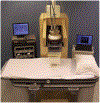Measurement of the liver iron concentration in transfusional iron overload by MRI R2* and by high-transition-temperature superconducting magnetic susceptometry
- PMID: 30754013
- PMCID: PMC6626578
- DOI: 10.1016/j.clinimag.2019.01.012
Measurement of the liver iron concentration in transfusional iron overload by MRI R2* and by high-transition-temperature superconducting magnetic susceptometry
Abstract
Purpose: To compare measurement of the liver iron concentration in patients with transfusional iron overload by magnetic resonance imaging (MRI), using R2*, and by magnetic susceptometry, using a new high-transitiontemperature (high-Tc; operating at 77 K, cooled by liquid nitrogen) superconducting magnetic susceptometer.
Methods: In 28 patients with transfusional iron overload, 43 measurements of the liver iron concentration were made by both R2* and high-Tc magnetic susceptometry.
Results: Measurements of the liver iron concentration by R2* and high-Tc magnetic susceptometry were significantly correlated when comparing all patients (Pearson's r = 0.91, p < 0.0001) and those with results by susceptometry >7 mg Fe/g liver, dry weight (r = 0.93, p = 0.006). In lower ranges of liver iron, no significant correlations between the two methods were found (0 to <3.2 mg Fe/g liver, dry weight: r = 0.2, p = 0.37; 3.2 to 7 mg Fe/g liver, dry weight: r = 0.41; p = 0.14).
Conclusion: The lack of linear correlation between R2* and magnetic susceptibility measurements of the liver iron concentration with minimal or modest iron overload may be due to the effects of fibrosis and other cellular pathology that interfere with R2* but do not appreciably alter magnetic susceptibility.
Keywords: High-transition-temperature superconductors; Liver iron concentration; MRI; Magnetic susceptometry; R2*; Superconducting transition temperature.
Copyright © 2019 Elsevier Inc. All rights reserved.
Figures


References
-
- Brittenham GM. Disorders of iron homeostasis: iron deficiency and overload In: Hoffman RBE, Silberstein LE, Heslop H, Weitz JI, Anastasi J, Salama ME, Abutalib SA, editor Hematology: Basic Principles and Practice. New York: Elsevier; 2018, p. 478–90.
-
- Porter JB, de Witte T, Cappellini MD, Gattermann N. New insights into transfusion-related iron toxicity: Implications for the oncologist. Critical reviews in oncology/hematology 2016;99:261–71. - PubMed
-
- Hoffbrand AV, Taher A, Cappellini MD. How I treat transfusional iron overload. Blood 2012;120(18):3657–69. - PubMed
Publication types
MeSH terms
Substances
Grants and funding
LinkOut - more resources
Full Text Sources
Medical

